Juntao Chen
Stackelberg Coupling of Online Representation Learning and Reinforcement Learning
Aug 10, 2025Abstract:Integrated, end-to-end learning of representations and policies remains a cornerstone of deep reinforcement learning (RL). However, to address the challenge of learning effective features from a sparse reward signal, recent trends have shifted towards adding complex auxiliary objectives or fully decoupling the two processes, often at the cost of increased design complexity. This work proposes an alternative to both decoupling and naive end-to-end learning, arguing that performance can be significantly improved by structuring the interaction between distinct perception and control networks with a principled, game-theoretic dynamic. We formalize this dynamic by introducing the Stackelberg Coupled Representation and Reinforcement Learning (SCORER) framework, which models the interaction between perception and control as a Stackelberg game. The perception network (leader) strategically learns features to benefit the control network (follower), whose own objective is to minimize its Bellman error. We approximate the game's equilibrium with a practical two-timescale algorithm. Applied to standard DQN variants on benchmark tasks, SCORER improves sample efficiency and final performance. Our results show that performance gains can be achieved through principled algorithmic design of the perception-control dynamic, without requiring complex auxiliary objectives or architectures.
SPRIG: Stackelberg Perception-Reinforcement Learning with Internal Game Dynamics
Feb 20, 2025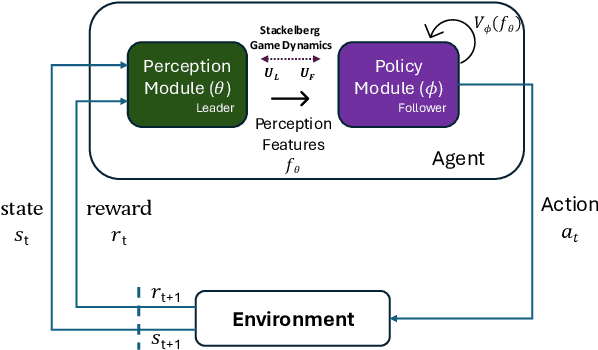
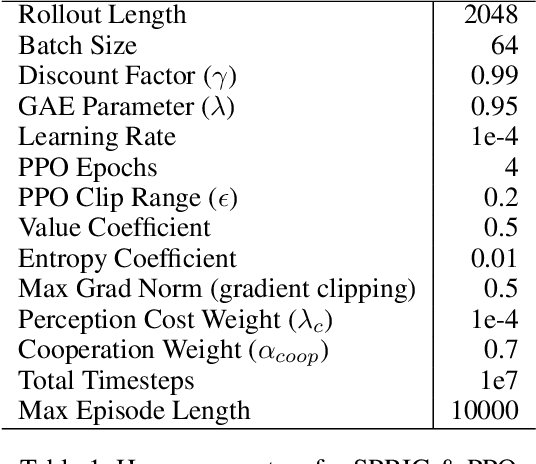
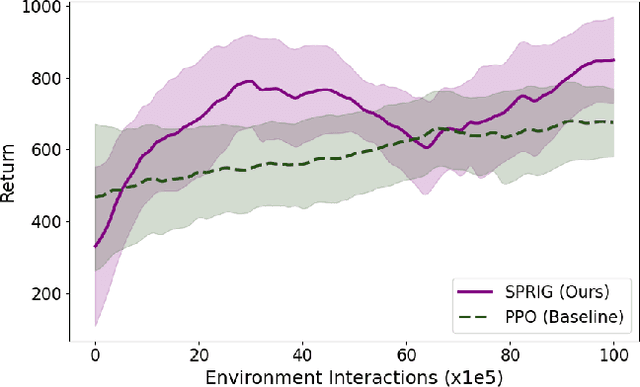
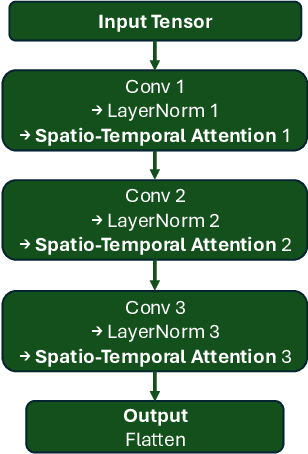
Abstract:Deep reinforcement learning agents often face challenges to effectively coordinate perception and decision-making components, particularly in environments with high-dimensional sensory inputs where feature relevance varies. This work introduces SPRIG (Stackelberg Perception-Reinforcement learning with Internal Game dynamics), a framework that models the internal perception-policy interaction within a single agent as a cooperative Stackelberg game. In SPRIG, the perception module acts as a leader, strategically processing raw sensory states, while the policy module follows, making decisions based on extracted features. SPRIG provides theoretical guarantees through a modified Bellman operator while preserving the benefits of modern policy optimization. Experimental results on the Atari BeamRider environment demonstrate SPRIG's effectiveness, achieving around 30% higher returns than standard PPO through its game-theoretical balance of feature extraction and decision-making.
Next-Generation Phishing: How LLM Agents Empower Cyber Attackers
Nov 21, 2024



Abstract:The escalating threat of phishing emails has become increasingly sophisticated with the rise of Large Language Models (LLMs). As attackers exploit LLMs to craft more convincing and evasive phishing emails, it is crucial to assess the resilience of current phishing defenses. In this study we conduct a comprehensive evaluation of traditional phishing detectors, such as Gmail Spam Filter, Apache SpamAssassin, and Proofpoint, as well as machine learning models like SVM, Logistic Regression, and Naive Bayes, in identifying both traditional and LLM-rephrased phishing emails. We also explore the emerging role of LLMs as phishing detection tools, a method already adopted by companies like NTT Security Holdings and JPMorgan Chase. Our results reveal notable declines in detection accuracy for rephrased emails across all detectors, highlighting critical weaknesses in current phishing defenses. As the threat landscape evolves, our findings underscore the need for stronger security controls and regulatory oversight on LLM-generated content to prevent its misuse in creating advanced phishing attacks. This study contributes to the development of more effective Cyber Threat Intelligence (CTI) by leveraging LLMs to generate diverse phishing variants that can be used for data augmentation, harnessing the power of LLMs to enhance phishing detection, and paving the way for more robust and adaptable threat detection systems.
Federated Learning for Discrete Optimal Transport with Large Population under Incomplete Information
Nov 12, 2024

Abstract:Optimal transport is a powerful framework for the efficient allocation of resources between sources and targets. However, traditional models often struggle to scale effectively in the presence of large and heterogeneous populations. In this work, we introduce a discrete optimal transport framework designed to handle large-scale, heterogeneous target populations, characterized by type distributions. We address two scenarios: one where the type distribution of targets is known, and one where it is unknown. For the known distribution, we propose a fully distributed algorithm to achieve optimal resource allocation. In the case of unknown distribution, we develop a federated learning-based approach that enables efficient computation of the optimal transport scheme while preserving privacy. Case studies are provided to evaluate the performance of our learning algorithm.
A Quantum-Classical Collaborative Training Architecture Based on Quantum State Fidelity
Feb 23, 2024
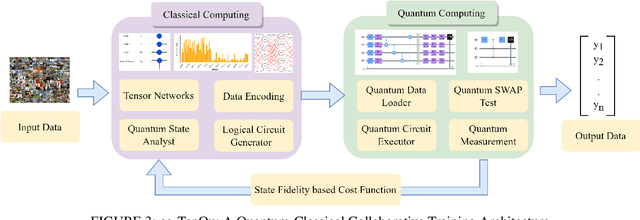


Abstract:Recent advancements have highlighted the limitations of current quantum systems, particularly the restricted number of qubits available on near-term quantum devices. This constraint greatly inhibits the range of applications that can leverage quantum computers. Moreover, as the available qubits increase, the computational complexity grows exponentially, posing additional challenges. Consequently, there is an urgent need to use qubits efficiently and mitigate both present limitations and future complexities. To address this, existing quantum applications attempt to integrate classical and quantum systems in a hybrid framework. In this study, we concentrate on quantum deep learning and introduce a collaborative classical-quantum architecture called co-TenQu. The classical component employs a tensor network for compression and feature extraction, enabling higher-dimensional data to be encoded onto logical quantum circuits with limited qubits. On the quantum side, we propose a quantum-state-fidelity-based evaluation function to iteratively train the network through a feedback loop between the two sides. co-TenQu has been implemented and evaluated with both simulators and the IBM-Q platform. Compared to state-of-the-art approaches, co-TenQu enhances a classical deep neural network by up to 41.72% in a fair setting. Additionally, it outperforms other quantum-based methods by up to 1.9 times and achieves similar accuracy while utilizing 70.59% fewer qubits.
UNO-QA: An Unsupervised Anomaly-Aware Framework with Test-Time Clustering for OCTA Image Quality Assessment
Dec 20, 2022



Abstract:Medical image quality assessment (MIQA) is a vital prerequisite in various medical image analysis applications. Most existing MIQA algorithms are fully supervised that request a large amount of annotated data. However, annotating medical images is time-consuming and labor-intensive. In this paper, we propose an unsupervised anomaly-aware framework with test-time clustering for optical coherence tomography angiography (OCTA) image quality assessment in a setting wherein only a set of high-quality samples are accessible in the training phase. Specifically, a feature-embedding-based low-quality representation module is proposed to quantify the quality of OCTA images and then to discriminate between outstanding quality and non-outstanding quality. Within the non-outstanding quality class, to further distinguish gradable images from ungradable ones, we perform dimension reduction and clustering of multi-scale image features extracted by the trained OCTA quality representation network. Extensive experiments are conducted on one publicly accessible dataset sOCTA-3*3-10k, with superiority of our proposed framework being successfully established.
Resilient and Decentralized Control of Multi-level Cooperative Mobile Networks to Maintain Connectivity under Adversarial Environment
Mar 16, 2016
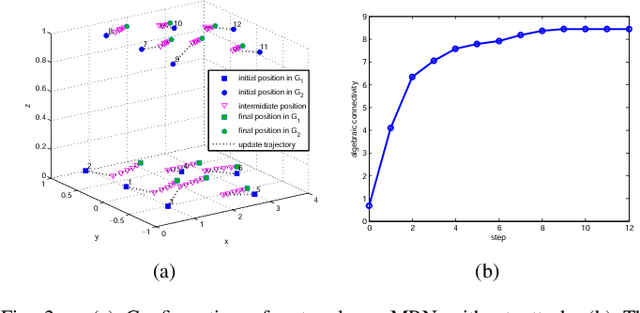
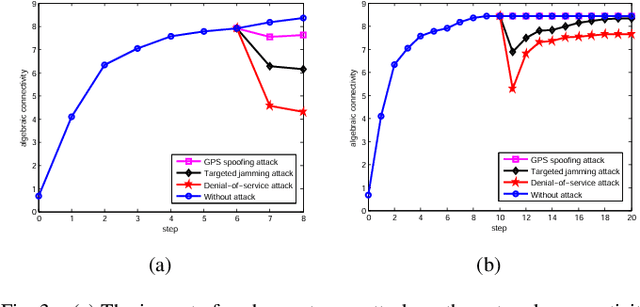
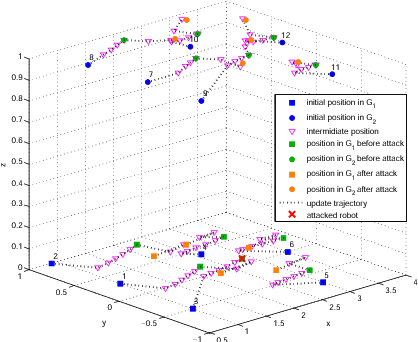
Abstract:Network connectivity plays an important role in the information exchange between different agents in the multi-level networks. In this paper, we establish a game-theoretic framework to capture the uncoordinated nature of the decision-making at different layers of the multi-level networks. Specifically, we design a decentralized algorithm that aims to maximize the algebraic connectivity of the global network iteratively. In addition, we show that the designed algorithm converges to a Nash equilibrium asymptotically and yields an equilibrium network. To study the network resiliency, we introduce three adversarial attack models and characterize their worst-case impacts on the network performance. Case studies based on a two-layer mobile robotic network are used to corroborate the effectiveness and resiliency of the proposed algorithm and show the interdependency between different layers of the network during the recovery processes.
 Add to Chrome
Add to Chrome Add to Firefox
Add to Firefox Add to Edge
Add to Edge